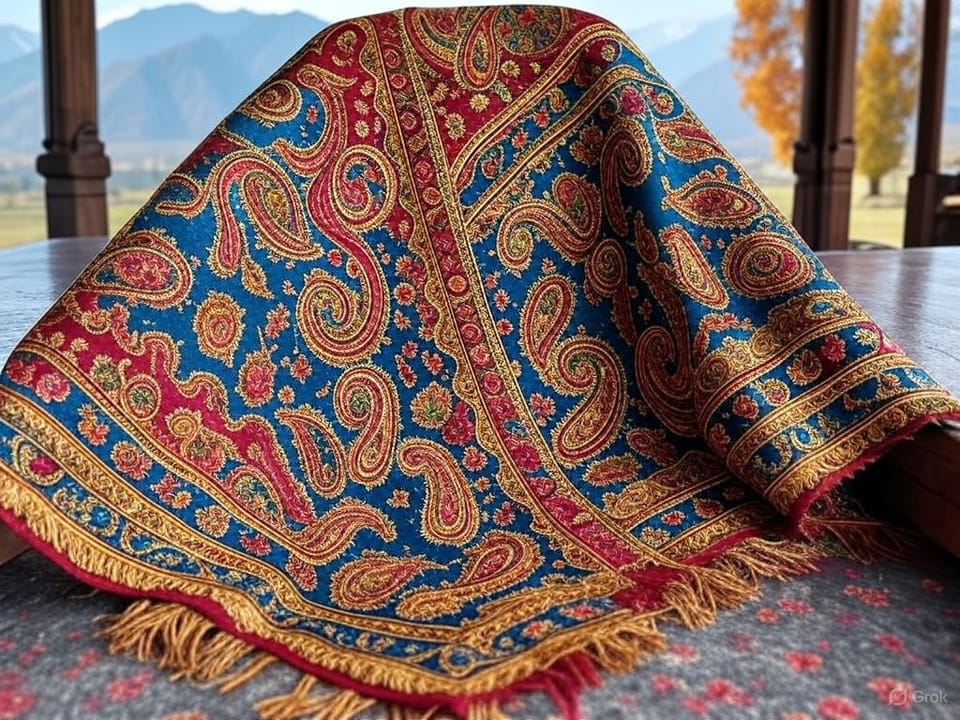Kashmiri Shawls: A Tapestry of Art and Tradition

Introduction
Kashmiri shawls are renowned worldwide for their exquisite craftsmanship, intricate designs, and luxurious feel. These handwoven textiles, often made from fine wool like pashmina or shahtoosh, are a testament to Kashmir's rich cultural heritage and artistic legacy. Worn by royalty, nobility, and connoisseurs of fine art, Kashmiri shawls have transcended time, remaining a symbol of elegance and tradition.
History
The art of shawl-making in Kashmir dates back centuries, with its origins traced to the 14th century during the reign of Sultan Zain-ul-Abidin, also known as Bud Shah. The ruler is credited with encouraging artisans from Central Asia, particularly Persia, to settle in Kashmir and share their weaving techniques. Over time, these techniques blended with local traditions, giving rise to the iconic Kashmiri shawl.
By the 18th and 19th centuries, Kashmiri shawls became highly coveted in Europe, especially during the Mughal era when they were gifted to royalty and aristocracy. The shawls' intricate embroidery and lightweight yet warm fabric made them a status symbol, often referred to as "cashmere" in the West, derived from the region's name.
Types of Kashmiri Shawls
Kashmiri shawls are primarily categorized based on their material and weaving techniques:
- Pashmina Shawls: Made from the fine undercoat of the Changthangi goat, pashmina shawls are celebrated for their softness, warmth, and lightweight nature. Authentic pashmina is hand-spun and handwoven, often adorned with delicate embroidery.
- Shahtoosh Shawls: Known as the "king of wool," shahtoosh is derived from the hair of the Tibetan antelope (chiru). These shawls are exceptionally fine and warm but are now banned due to conservation concerns surrounding the endangered chiru.
- Kani Shawls: These shawls are woven using the kani technique, where small wooden sticks (kani) are used to create intricate patterns. Kani shawls often feature vibrant, multicolored designs inspired by nature and Persian motifs.
- Embroidered Shawls: Many Kashmiri shawls, especially pashmina, are embellished with hand-stitched embroidery, such as sozni (needlework) or tilla (gold and silver thread work), adding to their aesthetic appeal.
Craftsmanship
The creation of a Kashmiri shawl is a labor-intensive process that involves multiple artisans, from spinners to weavers and embroiderers. The process begins with collecting raw wool, which is cleaned, spun, and dyed using natural or synthetic dyes. The weaving is done on traditional handlooms, a skill passed down through generations.
The hallmark of Kashmiri shawls is their intricate patterns, often inspired by nature—floral motifs, paisleys (known as boteh), and chinar leaves are common. The jamawar style, characterized by dense, all-over patterns, is particularly famous. Each shawl can take weeks to months to complete, depending on the complexity of the design.
Cultural Significance
Kashmiri shawls are more than just garments; they are a cultural emblem. They are often passed down as heirlooms, symbolizing familial heritage and pride. In Kashmiri weddings, shawls are gifted to brides as a mark of respect and affection. The shawl industry also plays a vital role in the region's economy, providing livelihoods to thousands of artisans.
Modern Challenges
Despite their global acclaim, the Kashmiri shawl industry faces challenges. The rise of machine-made imitations has threatened the market for authentic handwoven shawls. Additionally, geopolitical tensions and economic instability in the region have impacted the livelihoods of artisans. Efforts are underway to protect this craft through geographical indication (GI) tags and initiatives to promote authentic Kashmiri products.
Conclusion
Kashmiri shawls are a vibrant expression of the region's artistry, blending history, skill, and creativity. As symbols of luxury and tradition, they continue to captivate admirers worldwide. By supporting authentic Kashmiri craftsmanship, we can help preserve this timeless art form for future generations.
References
- Shaw, M. E. (2015). The Art of Kashmiri Shawls. New Delhi: Cultural Press.
- Ahmad, N. (2008). Handicrafts of Kashmir. Srinagar: Heritage Publishers.